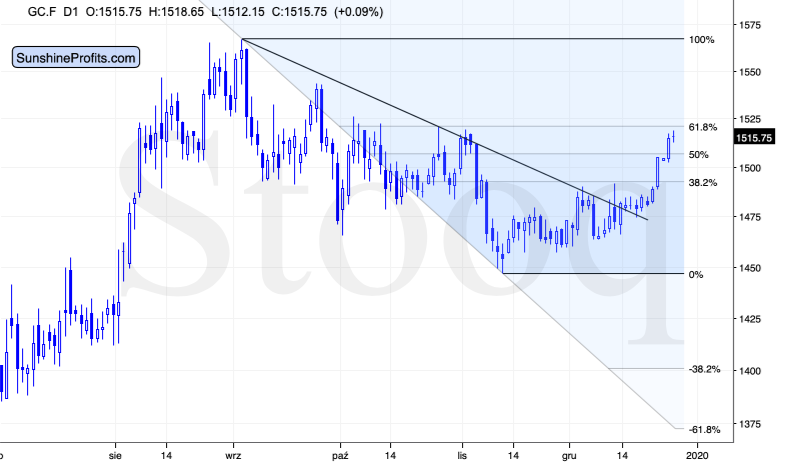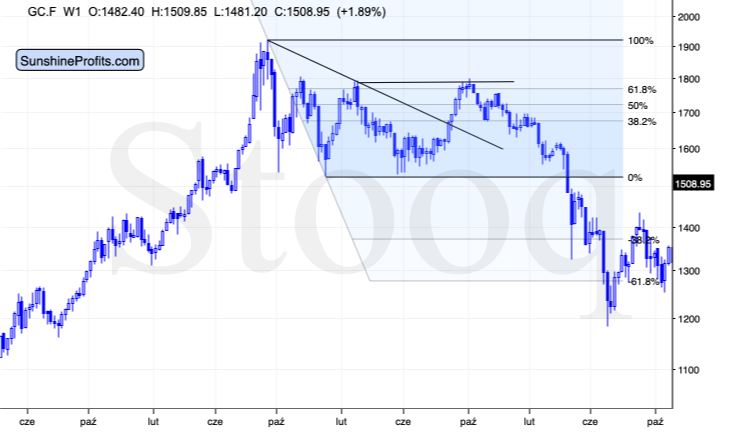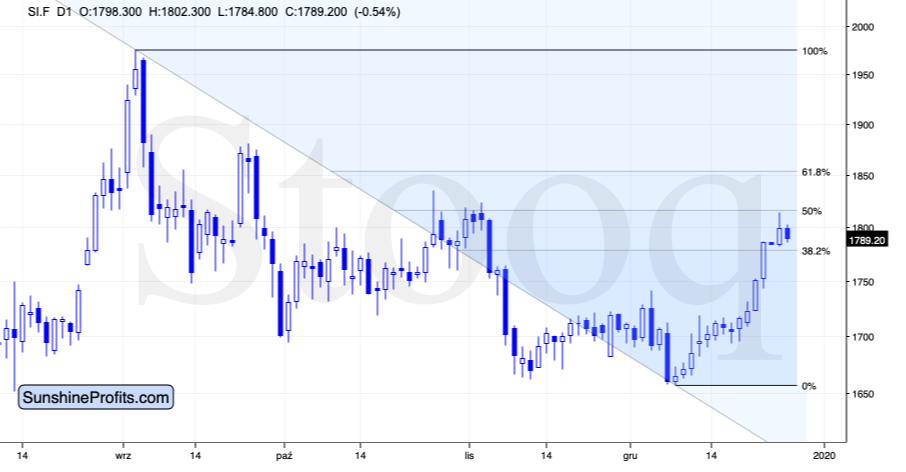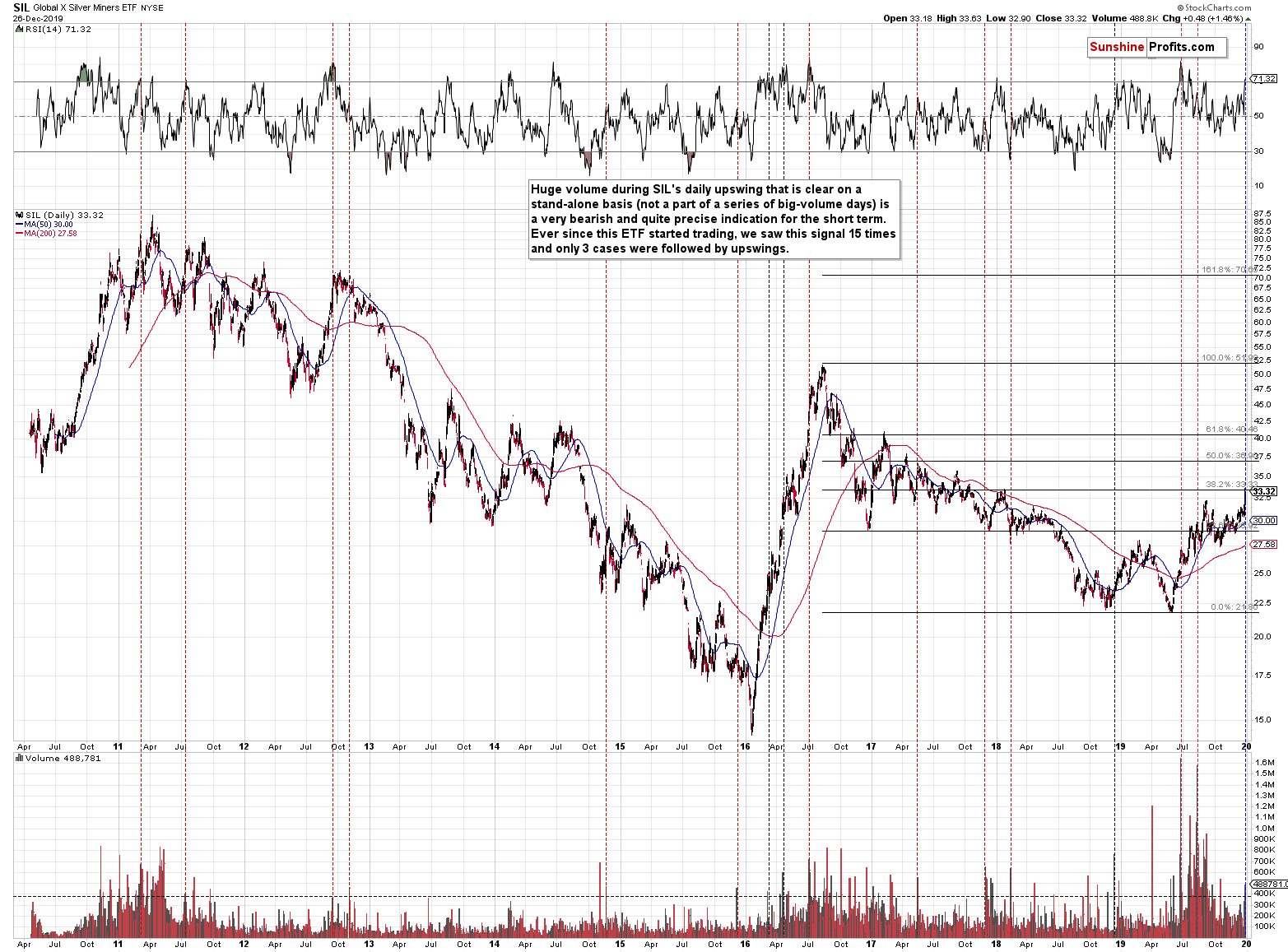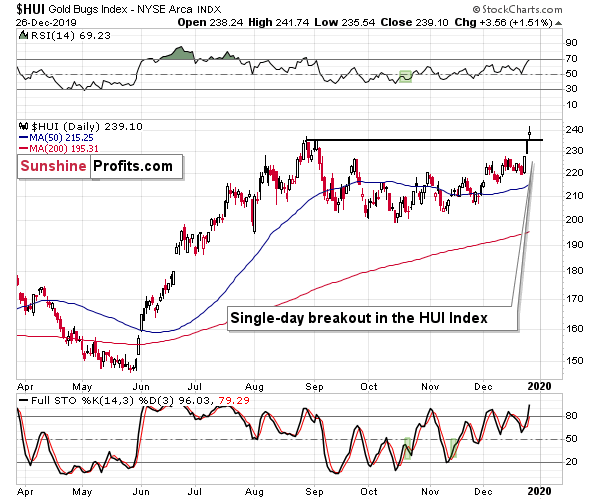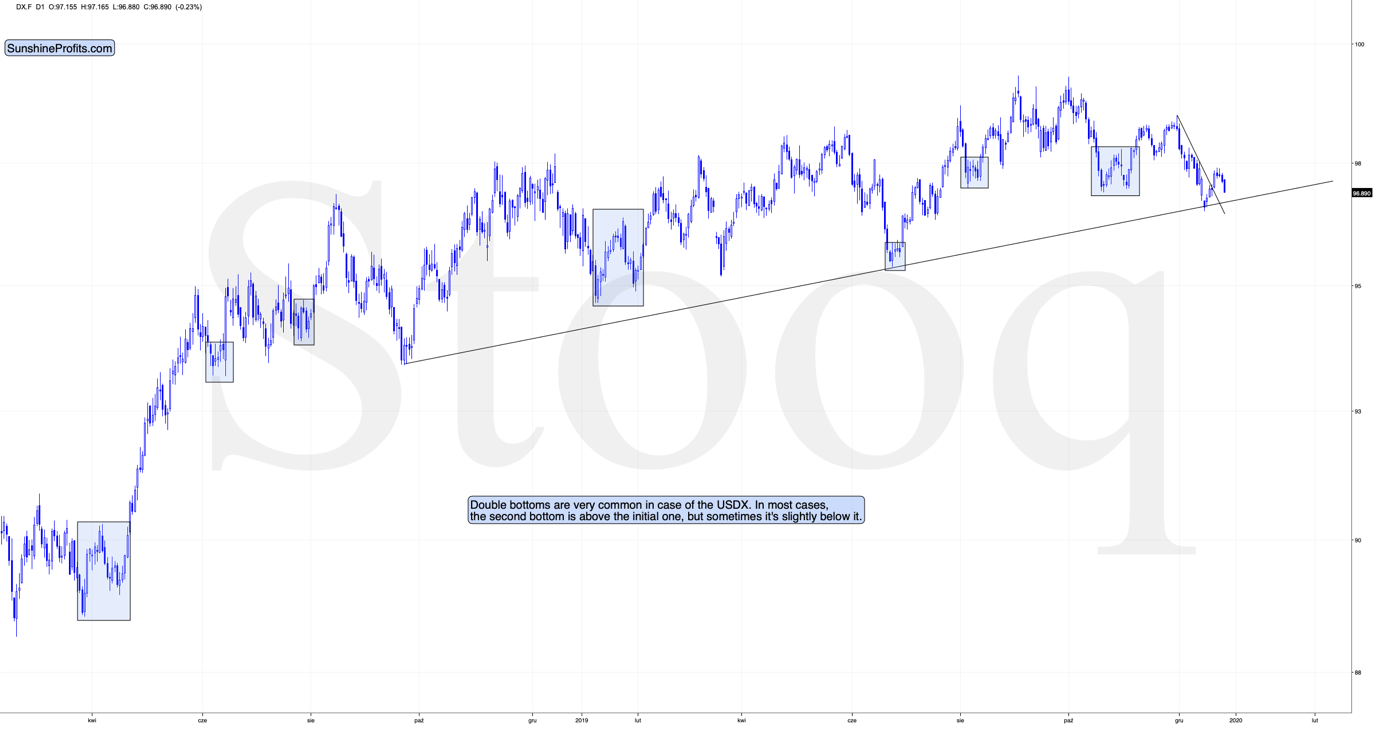Briefly: in our opinion, full (250% of the regular size of the position) speculative short position in gold, silver, and mining stocks is justified from the risk/reward point of view at the moment of publishing this Alert.
Gold stopped its rally just a few dollars below the upside target that we featured in yesterday's Alert. Gold moved a bit higher today but then declined back down without touching, let alone breaking above the 61.8% Fibonacci retracement level and the late-October and November highs. This means that what our yesterday's comments about the gold charts, remains up-to-date as well:
(...) the million-dollar question is how high is gold likely to move given its momentum and what does this move tell us for the outlook in the following months. Fortunately, we've seen this kind of price move before...
Gold is rallying sharply after breaking above the declining resistance line and the 38.2% Fibonacci retracement level. The breakout above these levels was not likely, but it happened, nonetheless. Given the move above the 50% retracement, it seems that gold could move to the classic 61.8% Fibonacci retracement before topping.
Please note that the 61.8% retracement is almost perfectly aligned with the late-October and November highs. Also, please note that the entire September - today decline is taking place after a sharp rally in gold.
Now, where did we see all that before?
In 2012.
Back then gold was also rallying sharply after breaking above the declining resistance line and moving above the 38.2% and 50% Fibonacci retracements.
Gold was after months of declines after the top, and the top was preceded by a sharp rally.
In both cases, gold also formed three separate bottoms before the final corrective upswing. Where did the 2012 corrective upswing end? Approximately at the 61.8% Fibonacci retracement and the previous high. This means that the current gold rally is also quite likely to end its rally at the analogous price level.
This target is at about $1,520 in case of gold futures. Today's pre-market high was about $1,510, which means that the possible upside is relatively close. This also means that it would be a good time to be opening positions aimed to profit from lower gold prices, instead of closing them.
Silver moved very close to its late-October and November highs as well.
The Silver Sign
In the white metal's case, it's the 50% Fibonacci retracement that serves as the resistance. This means that at the same time, silver is weak relative to gold (taking the medium term into account), while at the same time it's showing outperformance in the very short term. That's exactly what tends to happen close to tops.
And you know what else tends to happen near the tops?
Silver stocks' volume tends to spike. And guess what - we just saw that.
Silver Stocks Concur
Exactly that - a spike in silver's volume.
"Silver stocks reached their new yearly high on a relatively strong volume" - that sounds very bullish, doesn't it?
The problem is that reaching the new yearly high means that silver miners were barely able to correct 38.2% of the decline from the 2016 high. And that's compared to the decline alone. Comparing the recent rally to the one that we saw in 2016, we see that this year's upswing is barely one fifth of the previous upswing (about 50% vs about 250%). That's a very weak performance - silver miners don't really want to move higher, they are forced to move higher as gold and silver are rising, but the size of the move emphasizes that it's not the "true" direction in which the market really wants to be moving.
The volume is also not as bullish as it seems to be at first sight. Conversely, huge volume during SIL's daily upswing that is clear on a stand-alone basis (not a part of a series of big-volume days) is a very bearish and quite precise indication for the short term. Ever since this ETF started trading, we saw this signal 15 times and only 3 cases were followed by upswings.
Yes, the silver stocks moved sharply higher on a very short-term basis, but please note that they had moved sharply lower on a very short-term basis in early 2016. The opposite of the recent price action was what preceded the biggest and most volatile rally of the recent years. If we see a reversal and invalidation of the breakout to new 2019 highs, we'll have almost exactly the opposite situation and the implications will be even more bearish.
Speaking of invalidations, it seems that we might see one in the HUI Index as well.
Miners Throw In Their Two Cents
The gold miners just closed above the previous 2019 high. That happened for just one day and the breakout is not confirmed. Given that gold has almost reached its upside target, and that it's not really responding to today's decline in the USD Index, it seems that the breakout in the gold stocks will be invalidated shortly.
Speaking of the USD Index, let's take a look at its recent performance.
Meanwhile in the USD Index
The USDX seems to be forming the second bottom of the double-bottom formation. This type of bottom is very common for the USD Index and seeing it this time again, is quite normal. This means that the last couple days of declines are not out of the ordinary and that they don't change the bullish outlook.
The USDX seems to have bottomed at the rising medium-term support line, and the current move lower is just a verification of this bottom.
In most cases, the USDX forms its second bottom of the double-bottom formation higher than the first bottom, but that's not always the case. This means that the USDX is likely to bottom relatively close to its current price. This fits the scenario in which gold tops just a few dollars higher.
Naturally, the numerous other factors that we discussed previously continue to support lower precious metals prices in the following months. If you haven't read these analyses - especially the ones from the "critical" section, we strongly encourage you to do so. These are not quick reads, but they are really well worth the time spent reading them.
Key Factors to Keep in Mind
Critical factors:
- The USD Index broke above the very long-term resistance line and verified the breakout above it. Its huge upswing is already underway.
- The USD's long-term upswing is an extremely important and bearish factor for gold. There were only two similar cases in the past few decades, when USD Index was starting profound, long-term bull markets, and they were both accompanied by huge declines in gold and the rest of the precious metals market
- Out of these two similar cases, only one is very similar - the case when gold topped in February 1996. The similarity extends beyond gold's about a yearly delay in reaction to the USD's rally. Also the shape of gold price moves prior to the 1996 high and what we saw in the last couple of years is very similar, which confirm the analysis of the gold-USD link and the above-mentioned implications of USD Index's long-term breakout.
- The similarity between now and 1996 extends to silver and mining stocks - in other words, it goes beyond USD, gold-USD link, and gold itself. The white metal and its miners appear to be in a similar position as well, and the implications are particularly bearish for the miners. After their 1996 top, they erased more than 2/3rds of their prices.
- Many investors got excited by the gold-is-soaring theme in the last few months, but looking beyond the short-term moves, reveals that most of the precious metals sector didn't show substantial strength that would be really visible from the long-term perspective. Gold doesn't appear to be starting a new bull market here, but rather to be an exception from the rule.
- Gold stocks appear to be repeating their performance from 20 years ago, which means that a bottom in the entire precious metals sector is quite likely to form at much lower prices, in about a year
Very important, but not as critical factors:
- Long-term technical signs for silver, i.a. the analogy in terms of price to what we saw in 2008, shows that silver could slide even below $10.
- Silver's very long-term cycles point to a major reversal taking place right now and since the most recent move was up, the implications are bearish (this is also silver's technical sign, but it's so important that it deserves its own point)
- Long-term technical signs for gold stocks point to this not being a new gold bull market beginning. Among others, it's their long-term underperformance relative to gold that hint this is rather a corrective upswing within a bear market that is not over yet.
- Record-breaking weekly volume in gold is a strong sign pointing to lower gold prices
Important factors:
- Extreme volume reading in the SIL ETF (proxy for silver stocks) is an effective indication that lower values of silver miners are to be expected
- Silver's short-term outperformance of gold, and gold stocks' short-term underperformance of gold both confirm that the precious metals sector is topping here
- Gold topped almost right at its cyclical turning point, which makes the trend reversal more likely
- Copper broke below its head-and-shoulders pattern and confirmed the breakdown. The last time we saw something similar was in April 2013, when the entire precious metals sector was on the verge of plunging lower.
Moreover, please note that while there may be a recession threat, it doesn't mean that gold has to rally immediately. Both: recession and gold's multi-year rally could be many months away - comparing what happened to bond yields in the 90s confirms that.
Summary
Summing up, based on the similarity to the previous price moves, it seems that the rally in gold is now very close to being over. Too close for us to change the trading position at this time. The PMs were not likely to rally this significantly this week, but given that it had already happened, it seems that the very nearby turning points are likely to be tops, instead of bottoms. In other words, the profit potential of our trading positions remains not only intact, but it had actually increased as the downside targets remain unchanged.
As always, we'll keep you - our subscribers - informed.
To summarize:
Trading capital (supplementary part of the portfolio; our opinion): Full speculative short position (250% of the full position) in gold, silver, and mining stocks is justified from the risk/reward perspective with the following stop-loss orders and binding exit profit-take price levels:
- Gold futures: profit-take exit price: $1,391; stop-loss: $1,573; initial target price for the DGLD ETN: $36.37; stop-loss for the DGLD ETN: $25.44
- Silver futures: profit-take exit price: $15.11; stop-loss: $19.06; initial target price for the DSLV ETN: $24.88; stop-loss for the DSLV ETN: $14.07
- Mining stocks (price levels for the GDX ETF): profit-take exit price: $23.21; stop-loss: $30.11; initial target price for the DUST ETF: $14.69; stop-loss for the DUST ETF <to be updated on Monday>
In case one wants to bet on junior mining stocks' prices, here are the stop-loss details and target prices:
- GDXJ ETF: profit-take exit price: $30.32; stop-loss: $44.22
- JDST ETF: profit-take exit price: $35.88 stop-loss: <to be updated on Monday>
Long-term capital (core part of the portfolio; our opinion): No positions (in other words: cash)
Insurance capital (core part of the portfolio; our opinion): Full position
Whether you already subscribed or not, we encourage you to find out how to make the most of our alerts and read our replies to the most common alert-and-gold-trading-related-questions.
Please note that the in the trading section we describe the situation for the day that the alert is posted. In other words, it we are writing about a speculative position, it means that it is up-to-date on the day it was posted. We are also featuring the initial target prices, so that you can decide whether keeping a position on a given day is something that is in tune with your approach (some moves are too small for medium-term traders and some might appear too big for day-traders).
Plus, you might want to read why our stop-loss orders are usually relatively far from the current price.
Please note that a full position doesn't mean using all of the capital for a given trade. You will find details on our thoughts on gold portfolio structuring in the Key Insights section on our website.
As a reminder - "initial target price" means exactly that - an "initial" one, it's not a price level at which we suggest closing positions. If this becomes the case (like it did in the previous trade) we will refer to these levels as levels of exit orders (exactly as we've done previously). Stop-loss levels, however, are naturally not "initial", but something that, in our opinion, might be entered as an order.
Since it is impossible to synchronize target prices and stop-loss levels for all the ETFs and ETNs with the main markets that we provide these levels for (gold, silver and mining stocks - the GDX ETF), the stop-loss levels and target prices for other ETNs and ETF (among other: UGLD, DGLD, USLV, DSLV, NUGT, DUST, JNUG, JDST) are provided as supplementary, and not as "final". This means that if a stop-loss or a target level is reached for any of the "additional instruments" (DGLD for instance), but not for the "main instrument" (gold in this case), we will view positions in both gold and DGLD as still open and the stop-loss for DGLD would have to be moved lower. On the other hand, if gold moves to a stop-loss level but DGLD doesn't, then we will view both positions (in gold and DGLD) as closed. In other words, since it's not possible to be 100% certain that each related instrument moves to a given level when the underlying instrument does, we can't provide levels that would be binding. The levels that we do provide are our best estimate of the levels that will correspond to the levels in the underlying assets, but it will be the underlying assets that one will need to focus on regarding the signs pointing to closing a given position or keeping it open. We might adjust the levels in the "additional instruments" without adjusting the levels in the "main instruments", which will simply mean that we have improved our estimation of these levels, not that we changed our outlook on the markets. We are already working on a tool that would update these levels on a daily basis for the most popular ETFs, ETNs and individual mining stocks.
Our preferred ways to invest in and to trade gold along with the reasoning can be found in the how to buy gold section. Additionally, our preferred ETFs and ETNs can be found in our Gold & Silver ETF Ranking.
As a reminder, Gold & Silver Trading Alerts are posted before or on each trading day (we usually post them before the opening bell, but we don't promise doing that each day). If there's anything urgent, we will send you an additional small alert before posting the main one.
Thank you.
Sincerely,
Przemyslaw Radomski, CFA
Editor-in-chief, Gold & Silver Fund Manager


